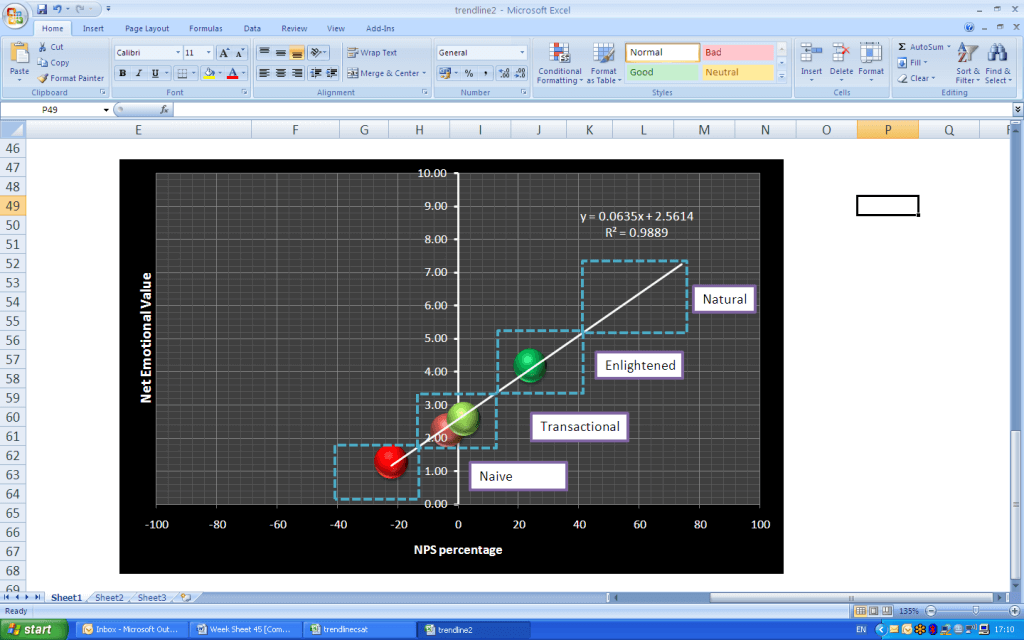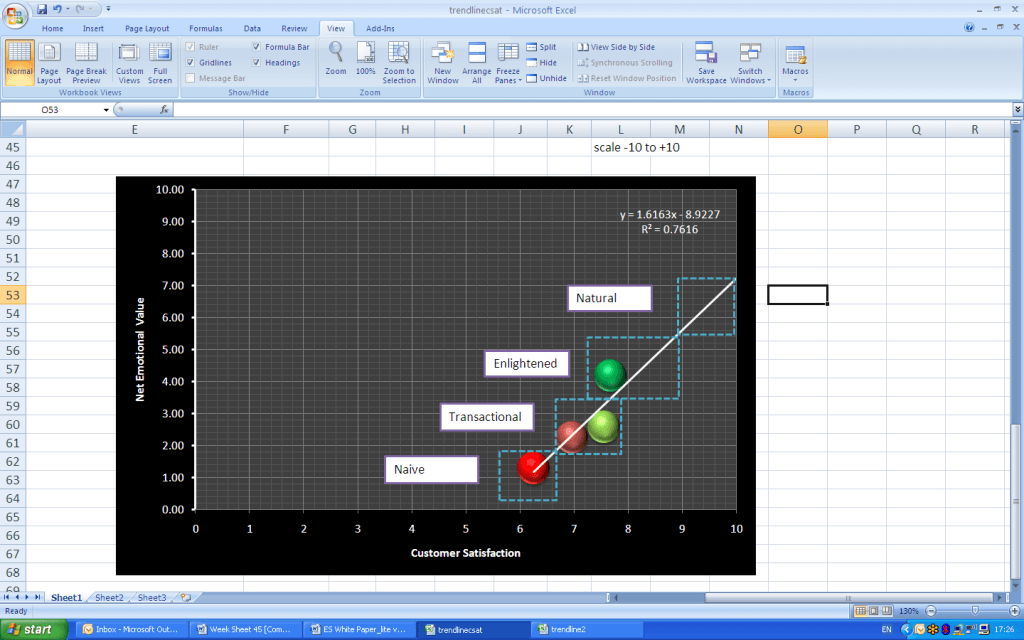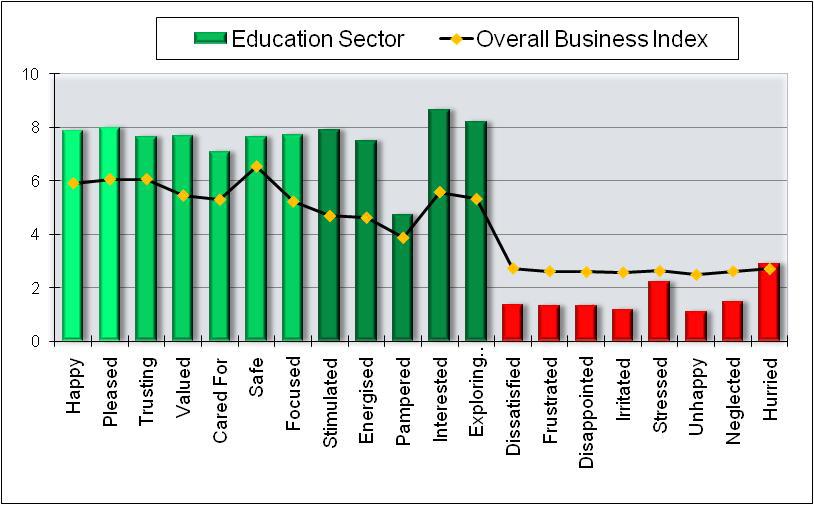Over the past 7 years of analysing emotions, Beyond Philosophy has built up a wealth of experience on how to measure emotions and how to understand what drives emotion. However, there is no point in looking at emotion unless it drives value to your business. So with this in mind we have recently gone beyond individual client engagements to see if more generally there is a relationship between emotion and key KPIs Net Promoter® and CSAT.
To do this we have developed a single emotion number called Net Emotional Value.
Introducing Net Emotional Value
Net Emotional Value is a single number that represents how your customers ‘on balance’ feel towards you. To put it simply NEV is the net of positive emotions less negative emotions.
A simple calculation based on our Emotion Scale for NEV would be:
NEV = Average of the Positive Emotions (Happy, Pleased, Trusting, Valued, Cared for, Safe, Focused, Indulgent, Stimulated, Exploratory, Interested, Energetic) – Average of the Negative Emotions (Dissatisfied, Frustrated, Disappointed, Irritated, Stressed, Unhappy, Neglected, Hurried)
It is slightly more complex if your business has positive attention emotions that drive value but the principle is the same.
Demonstrating the relationship between NEV, NPS and CSAT
Critically when we take the NEV and correlate this to NPS scores provided by each respondent we can derive an NEV/ NPS relationship chart that should support or refute our central hypothesis that:
H1: The higher the NEV the Higher the NPS
In addition we also have used this to test other value indicators such as Customer Satisfaction.
If this relationship holds, it means that there is an emotional underpinning behind Net Promoter® (i.e., loyalty) and Customer Satisfaction such that any change in one reflects in a change in the other. In other words for management, Satisfaction and Recommendation/ loyalty must be effected by emotional response not just rational response alone
The following chart shows our results:
- Naive represents those companies with a net negative emotional feel.
- Transactional represents those companies with a low emotional feel overall (neither positive nor negative) – hence low on positives and low on negatives.
- Enlightened represents those companies with a high positive emotional feel.
- Natural represents those companies with a very high positive emotional feel.
Note that these names also fit within the Beyond Philosophy typology of organisations based on how CE centric they are. We believe there is a direct link between emotional engagement and the degree to which the internal organisation is CE focused.
NEV/ NPS relationship
Figure 1: Net Emotional Value and its relationship to NPS percentages
As we can see from figure 1 the relationship between the profiles and the Net Promoter® percentages holds, forming a linear relationship between NPS percentages and NEV scores.
Extrapolating this line in to the zone identified as key to high growth (40% and above on NPS) we define a zone where the difference between positive average emotion scores and negative emotion scores is visually described as 5 points or above (i.e., an average of 2 out of 10 on negative emotions must be counterbalanced by an average score of at least 7 out of 10 on all positive emotions).
Our conclusion is that companies driving NPS are focused on emotional engagement.
NEV/ CSAT relationship
Figure 2: Net Emotional Value and its relationship to Customer Satisfaction
As we can see from the above figure 2 the relationship between the NEV profiles and customer satisfaction again holds a linear relationship. The relationship is less apparent than for Net Promoter® but nonetheless demonstrates continuity between growth in customer satisfaction and Net Emotional Value.
Interestingly we can see that there are two transactional states where the relationship is similar. So if a company is evoking strong positive AND negative emotions this can lead to a similar rate of growth in CSAT or NPS as if the company was evoking little emotion at all! In other words, emotions need to be evoked and controlled.
In addition, we also see that the move from Transactional (low emotional feel overall) to Enlightened (a higher positive emotional feel) is less about controlling negatives (which are typically already at a low level in the Transactional type – which also has low positive emotions) than about generating more positive emotions i.e., enlightened states are more positively engaged emotionally.
It can be seen that the Natural state is hypothesised from this dataset as involving high positive emotions. Unsurprisingly, the dataset does not contain natural industry types (although there are types by company). Competitive confidence only allows us to express types by industry. For completion we include the Natural profile from one (undisclosed company, N=1,319).
Figure 3: Example Natural Profile
In this case, we can see that the attention emotions are pulled up to the high level of the positive recommendation and advocacy emotion sets.
Management Implications
Understand your NEV score and diagnose how you can move your emotion scores higher.







To begin, many of us can readily agree with the basic premise that emotional elements, as well as rational elements, of perceived value drive much of b2b and b2c customer decision-making. This has been well-proven. However, if the core measures for understanding behavior are flawed and have limited proven actionability, then, correlations notwithstanding, the premise of connecting them (satisfaction and NPS) to an emotional net score sits on a very weak foundation.
First, satisfaction is a passive, reactive, and benign measure that has been repeatedly found to have weak and inconsistent connection to actual behavior. Lots of studies have proven this, but here’s just one example. Fred Reichheld, the co-inventor of NPS, once demonstrated this when he found 0.00 correlation between satisfaction score changes and sales groowth by evaluating these dimensions for all companies in the ACSI.
Next, although Bain and Satmetrix would like everyone to accept that NPS, advocacy, and loyalty are pretty much the same measures, the premise that Net Promoter and loyalty are identical concepts, representing the same behavior, has been disproven over and over. Here are just a few examples from CustomerThink posts, including one of my own:
http://www.customerthink.com/blog/sorry_nps_i_m_not_buying_it
http://www.customerthink.com/blog/unmasking_the_problem_with_net_scores_and_the_nps_claims
http://www.customerthink.com/article/customer_advocacy_behavior_personal_brand_connection
http://www.customerthink.com/blog/net_promoter_acsi_smackdown
http://www.customerthink.com/blog/playing_only_to_net_promoter_score_nps_promoters_good_business_or_risky_venture
So, just subtracting negative from positive emotions is subject to the same logic and actionability challenges as subtracting negative from positive recommendation, and negative word-of-mouth from positive word-of-mouth and calling it ‘net advocacy’, as I have also seen done.
Michael.
Thank you for your challenge.
If I may paraphrase, you seem to be saying 'emotions' are important to consider as well as the rational experience as drivers of behaviour. But CSAT and NPS are not drivers of behaviour. Therefore a link between, NEV and these is a weak foundation.
Several points on this:
In the broader model we do link to behaviour – we agree with you
1. NEV is part of a model called Emotional Signature. In the full model, I totally agree with you, you need to link to behaviour both in terms of what does emotion mean (what does it relate to – find out, don't just depend on folklore) and in terms of outcome, does it drive spend, tenure, attitude (and if attitude-is there really a link or can we change the ground rules of our business by changing its meaning: 8/10 CSAT in Aldi is not the same as 8/10 in Waitrose).
2. Our standard approach is based on modeling customer's responses – both emotional and non-emotional – to stimuli of an experience and whether this drives a basket of KPIs and behavioural values in a SEM based model. So we would not say, (1) just focus on one KPI, (2) don't consider the behavioural antecedents (3) only consider emotional effects. Nor for that matter just consider a 'pull the lever' model, Customer's also have future desires (akin to the If-Then emotion rules of Baumeister).
CSAT and NPS in a theoretical past based mathematical model may be weak, but in fact they do drive 'firm' action
3. On CSAT and NPS, I am fine with your view about CSAT and NPS. In fact, as you know Tim Keiningham wrote a challenging paper on NPS. My point for this paper was to look at it another way. These are the Key KPIs that within business whether you like it or not do drive action by the firm.
4. Improvements in CSAT, NPS have been the lens by which firms 'change the ground rules of their business'. In this sense, even when before they have not demonstrated a link to behaviour, that does not mean that they might not do
5. It depends, each firm is different, in some firms CSAT may work great (it is not just about satisfied or not by the way, it is a scale measure to very satisfied so not emotionally neutral).
NEV is part of an appraisal system. All relationships come from the full model.
I follow appraisal theories of emotion so do not believe that emotion and rationality should be so clearly split as in marketing folklore. The evidence for this is in Baumeister, Clore and Ortoney, Lazarus and Cognitive Theories of Emotion.
• (source: Phil Barden) I think the essence of the issue is this – what drives behaviour? Although it’s been shorthand for years, the emotion vs rational model is an unhelpful dichotomy here. Our work is based on Kahneman/Camerer’s dual system approach (behaviour requires a fluid interaction between controlled and automatic processes, and between cognitive and affective systems) and we have a model of ‘neuro-psychological goals’ derived from neuroscience, cognitive & social psychology that we use to explain behaviour, including brand choice (it’s the best I’ve seen in my 25 years client-side brand management experience). We find this approach immensely more helpful than simply emotional & rational. In this context, the role of emotion is as a way of understanding where I am in my level of goal attainment. Emotion on its own is not sufficient. It’s perfectly possible, for example, to like something but not want it – so the crucial thing is to understand the underlying goal, because that’s the behavioural driver.
However, I would ask you to go beyond the marketing folklore: here is a link to my article on research-live in response to emotion folklore.
http://www.research-live.com/features/measuring-emotion/counting-the-beats-a-critique/4006179.article